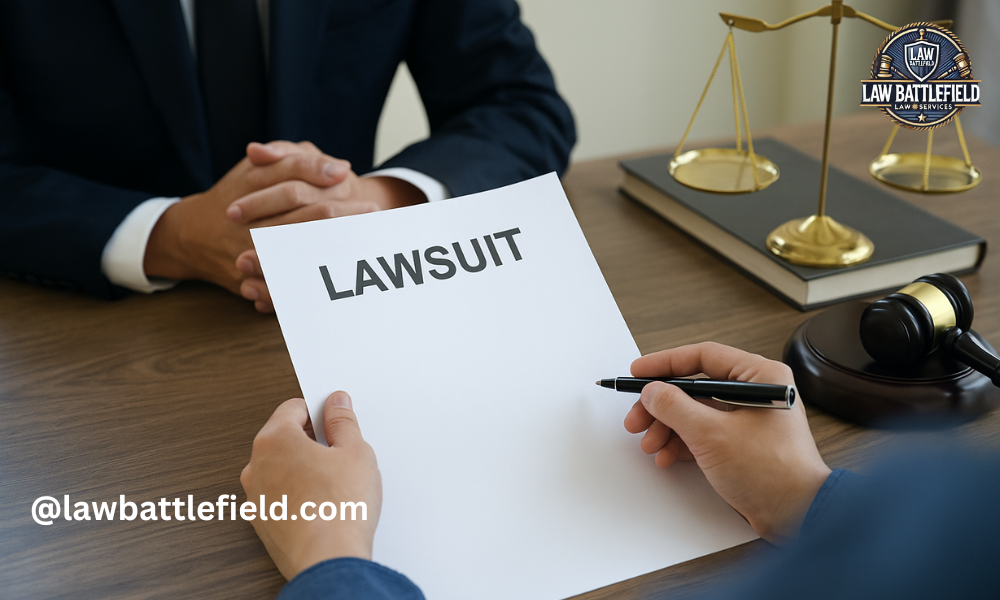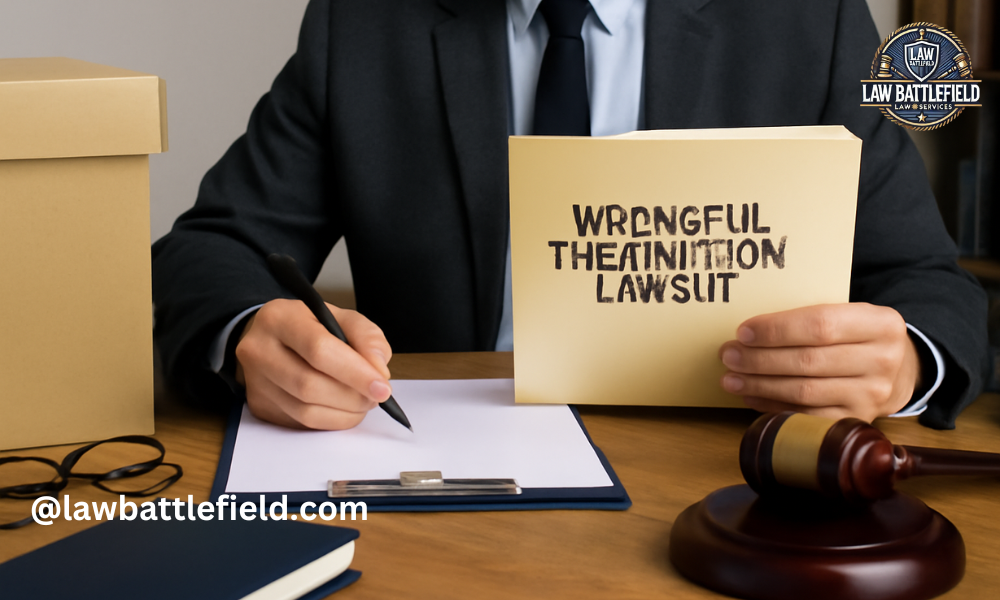Many workers wonder how to file a lawsuit against your employer when they feel their rights have been violated. This step can feel overwhelming, but sometimes it is the only way to protect yourself and seek justice.
An employee may think about taking legal action for different reasons. It could be because of discrimination at work, unfair treatment after reporting an issue (retaliation), unpaid or missing wages, or even wrongful termination. Each of these situations can have a serious impact on your income, your career, and your peace of mind.
This guide is designed to give you a clear picture of what to expect if you decide to move forward. You will learn the steps, what documents you need, how the legal process works, and what outcomes are possible. The aim is to make the idea of filing a lawsuit less confusing and help you understand how to protect your rights in a professional way.
Know Your Rights & Grounds for Filing
Before you start learning how to file a lawsuit against your employer, it is important to know what the law protects. A lawsuit is not only about feeling wronged. It must be based on a legal right that has been violated.
Some of the main legal grounds include:
- Discrimination laws – These protect you from unfair treatment based on race, gender, religion, age, disability, or other protected traits.
- Wage and hour laws – These ensure you are paid fairly for the work you do. Issues like unpaid overtime, withheld wages, or being forced to work off the clock may fall here.
- Contract law – If you signed an employment contract and the employer broke the terms, that can give you legal standing.
- Wrongful termination – Being fired for illegal reasons, such as reporting unsafe work conditions or filing a complaint, may count as wrongful dismissal.
Common examples of employer conduct that can lead to a valid claim include:
- Workplace harassment from managers or coworkers.
- Unpaid wages or failure to follow overtime laws.
- Retaliation after you reported discrimination, safety concerns, or misconduct.
- Wrongful dismissal, where the firing was not for a legal reason.
Not every unfair situation counts as a lawsuit. You must show a clear violation of law or contract. Knowing this difference will save you time and help you decide the right path forward.
Documenting The Facts & Gathering Evidence
When you think about how to file a lawsuit against your employer, one of the most important steps is building strong evidence. A case is only as strong as the proof behind it. Judges and lawyers rely on documents and records, not just personal stories.
Here is a clear step-by-step approach:
- Create a timeline – Write down the events in order. Include dates, times, people involved, and what exactly happened. This helps your lawyer and the court see the full picture.
- Collect emails and messages – Save any communication that shows unfair treatment, harassment, or denial of pay. Screenshots and printed copies are helpful.
- Keep pay stubs and HR papers – Store copies of pay records, performance reviews, contracts, and complaints filed with HR. These can prove what you were owed or how you were treated.
- Gather witness support – If coworkers saw what happened, ask if they are willing to give a statement.
Why does this matter? Because lawsuits are decided on evidence. Proof shows what happened and when it happened. Without it, even a true story may be hard to prove in court.
A few tips: collect and secure evidence as soon as you can. Do not delete emails, throw away papers, or change records. Even small details may become important later.
Internal Remedies & Agency Filing Before Suit
Before you move forward with how to file a lawsuit against your employer, you may need to take some first steps inside the company or with a government agency. Many cases require you to try these channels before going to court.
Internal Complaint Procedures
Most workplaces have an HR department or a grievance system. If you face discrimination, harassment, or wage problems, it is often best to first report it through these channels. Filing an internal complaint shows that you gave the employer a chance to correct the problem.
Government Agency Filings
In some cases, you cannot file a lawsuit right away. For example, discrimination or retaliation claims often require a complaint with the Equal Employment Opportunity Commission (EEOC) or your state’s labor agency first. The EEOC will review your case and may issue a “right to sue” letter. This letter gives you permission to file a lawsuit in court.
Deadlines And Time Limits
Employment law has strict timelines. You must act within a certain period:
- EEOC complaints usually must be filed within 180 to 300 days of the event.
- Wage claims or contract disputes may have deadlines set by state or federal law.
- Missing these deadlines can prevent you from moving forward, even if your claim is strong.
Understanding these rules helps you avoid mistakes. Filing the right paperwork on time is one of the key steps in protecting your rights before starting a lawsuit.
Deciding To Hire An Employment Lawyer
When you are learning how to file a lawsuit against your employer, one of the most important choices is whether to hire a lawyer. Employment law can be complex, and many cases are difficult to handle alone. An attorney with experience in this area understands the process and knows how to protect your rights.
Why it makes sense
- A lawyer can explain if your claim is strong enough to succeed.
- They know which court or agency is right for your case.
- They protect you from mistakes that can delay or weaken your claim.
What to look for in a lawyer
- Expertise – Choose someone who focuses on employment law.
- Track record – Ask if they have handled cases similar to yours.
- Fee structure – Some work on contingency, meaning they only get paid if you win. Others may charge hourly or flat fees.
How a lawyer helps in the process
- Filing the complaint – They prepare the legal documents with correct facts and claims.
- Navigating discovery – They handle requests for documents, depositions, and responses.
- Negotiating – Many cases settle before trial. A lawyer can negotiate a fair settlement and advise you on whether to accept or go to court.
Having an experienced lawyer by your side often gives you a stronger chance of success. They bring knowledge, resources, and strategy to your case.
Filing The Complaint Against Your Employer
Once you have prepared your case, the next step in how to file a lawsuit against your employer is writing and submitting the complaint. The complaint is the official document that starts the lawsuit in court.
How To Draft A Complaint
A complaint usually includes:
- Parties – who is filing (the employee) and who is being sued (the employer).
- Facts – a clear outline of what happened, when it happened, and why it was unlawful.
- Legal claims – the specific laws or contracts that were violated.
- Relief requested – what you want from the lawsuit, such as unpaid wages, reinstatement, or compensation for damages.
Choosing State Or Federal Court
The right court depends on your claim:
- State court often handles contract disputes, wage claims, and wrongful termination cases under state law.
- Federal court is used for cases involving federal laws, such as discrimination under Title VII or the Fair Labor Standards Act.
The choice may also depend on where the employer is located and where the events took place.
Service Of Process And Response
After filing, the complaint must be officially delivered to your employer. This is called service of process. It ensures the employer is formally notified. Once served, the employer has a set number of days, usually 20 to 30 days, to respond. The response may admit or deny the claims, or try to dismiss the case.
This step makes your case official. From here, the legal process moves forward into discovery and trial preparation.
The Litigation Process: What To Expect
After the complaint is filed, the lawsuit begins to move forward. Understanding each stage helps you know what lies ahead in how to file a lawsuit against your employer.
Employer’s Answer
Once served, the employer has a deadline to respond. They may admit or deny your claims, raise defenses, or file a motion to dismiss the case.
Discovery Stage
This is where both sides collect and exchange information. It may include:
- Document requests – payroll records, HR reports, emails, or performance reviews.
- Depositions – interviews under oath where lawyers ask questions and record answers.
- Interrogatories – written questions answered under oath.
Discovery is often the longest and most detailed part of the lawsuit.
Motions And Settlement Talks
Before trial, either side can file motions. A common one is summary judgment, where the employer argues there is not enough evidence to continue. At the same time, settlement talks may happen. Many employment lawsuits end with a settlement instead of going to trial.
Trial And Possible Outcomes
If the case does not settle, it goes to trial. A judge or jury will hear the evidence and make a decision. This can include awarding damages, reinstating your job, or ordering other relief.
Timeline And Costs
Employment lawsuits can take months or even years depending on the complexity. Costs also vary, from filing fees to legal fees. This is why many employees choose to settle, since trial can be expensive and stressful.
Knowing this process in advance helps you stay realistic about time, cost, and possible outcomes.
Settlement, Remedies & Common Pitfalls
In most cases of how to file a lawsuit against your employer, the process ends before trial. Settlement is the most common outcome, but it is important to understand what you may receive and what risks to avoid.
Types Of Remedies
If your case is successful, possible remedies may include:
- Back pay – money owed for lost wages or benefits.
- Front pay – compensation for future lost earnings if you cannot return to the same job.
- Emotional distress – payment for the stress and harm caused by the employer’s actions.
- Punitive damages – extra payment meant to punish an employer for serious misconduct.
Settlement vs Trial
- Settlement pros – faster resolution, less cost, more privacy, guaranteed outcome.
- Settlement cons – you may receive less than what you could win at trial.
- Trial pros – chance for full compensation and public accountability.
- Trial cons – takes longer, costs more, outcome is uncertain.
Common Pitfalls
Many employees weaken their case by:
- Missing deadlines – failing to file complaints or lawsuits on time.
- Signing release forms too quickly – employers may offer severance agreements that waive your right to sue. Never sign without legal advice.
- Poor evidence – going to court without clear documents, witnesses, or records makes it harder to win.
Knowing these remedies and risks helps you make smart choices, whether you settle or go to trial.
Conclusion
Learning how to file a lawsuit against your employer is not only about knowing the legal steps. It is about protecting your rights and acting within the right time limits. Missing deadlines or ignoring the process can take away your chance to be heard.
Before you move forward, take time to ask yourself if your situation is supported by law. Make sure you have strong evidence and clear records. Speak with an employment lawyer if possible, as they can guide you through the process and help you avoid costly mistakes.
Filing a lawsuit can feel stressful, but it may also be the best way to hold an employer accountable. It can bring back lost wages, protect your career, and provide justice when your rights have been violated. With the right steps, preparation, and support, you can face the process with confidence.
Frequently Asked Questions (FAQ)
How Do I Know If I Can File A Lawsuit Against My Employer?
You can file if your employer violated a law or contract, such as discrimination, retaliation, unpaid wages, or wrongful termination.
Do I Need A Lawyer To Sue My Employer?
You are not required to hire one, but an employment lawyer increases your chances of success and helps avoid mistakes.
How Long Do I Have To File A Lawsuit Against My Employer?
Deadlines vary. For discrimination, you may need to file with the EEOC within 180–300 days. Other claims may have different time limits set by law.
What Outcomes Can I Expect If I Sue My Employer?
Possible remedies include back pay, front pay, emotional distress damages, and sometimes punitive damages. Many cases also settle before trial.
Is Suing My Employer Worth It?
It depends on your case. Lawsuits can be long and stressful, but they can also bring justice, compensation, and accountability.
Was this article helpful? Check out more on Lawbattlefield.com
Disclaimer: This article on how to file a lawsuit against your employer is written for general informational purposes only. It does not provide legal advice and should not be taken as a substitute for consultation with a qualified attorney. Employment laws can vary by state, country, and individual circumstances. If you believe you have a legal claim against your employer, you should seek guidance from a licensed employment lawyer or legal professional in your area.
What Is Discovery In A Lawsuit? A Simple Guide To The Legal Process





